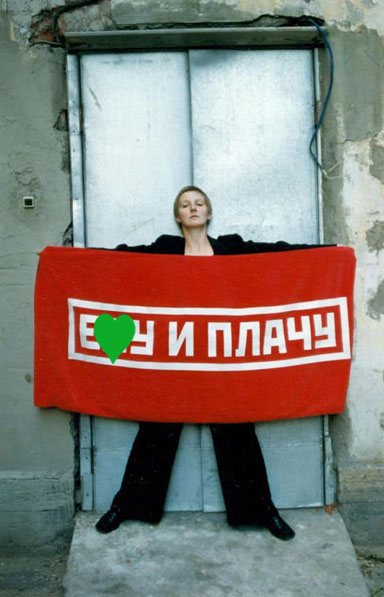|
I’m screwing them and can’t stop sobbing WHO IS MARINA KOLDOBSKAYA Marina Koldobskaya is an artist and a critic, curator and poet, journalist and, finally, museum director. One in six persons, and in all of them – splendid. This pro-theistic charm creates certain dumbfoundedness: the moments you start talking to her as an artist, as she – bang! – shows you her Playboy article; as soon as you get used to her as a journalist, she – slam! – publishes a book of poetry; by the time you read her poems, she is already a big boss. And to write about the “artist Marina Koldobskaya” separately from her other social roles is altogether impossible. She is the Ulysses of the St. Petersburg scene because her odyssey defies any prognosis. I will not be in the least surprised if tomorrow Marina Koldobskaya turns out to be a water-ski instructor on the Neva River or the café manager at Art Center Pushkinskaya-10. For Marina certainly is a child of the Pushkinskaya (it is precisely there, in the building of bourgeoisified squatters, that her studio is located). She was brought by the wind of freedom of the late eighties, and her metamorphoses are a lifelong project that her colleagues won’t or can’t effect in such a variety. Marina Koldobskaya is a total diversionist. Her articles are the art project of an artist. Her paintings are the intrusion of a journalist into the body of fine arts. In all her incarnations, the anti-institutional pathos is revealed with such a triumphant force that one would fear for the land of St. Petersburg, were this energy channeled differently. But, thank God, she is way too ironic. Eduard Limonov contrived to nail the hammer-and-sickle to the center of the Nazi banner. He founded the movement of national bolshevists. Were Limonov even a little bit more koldobskayaesque, he would have completed his aesthetic move by uniting the hammer-and-sickle and the swastika with the yin-yang. But Marina had already done this for him. Were she a little bit more limonovesque, then, having come up with such a symbol, she would have founded a sect of radical red-riding-hoods – Buddhists with black belts – and waged a war for the vegetarian fascism. But she is way too ironic, praise be to Allah. The position of Marina Koldobskaya is always in between. Between politics and art. Between journalism and poetry. Marusya Klimova called the artistic worldview of Marina Koldobskaya a “political postmodernism”. Works of Marina Koldobskaya are deconstructive. They destroy the system of symbolic exchange and assert her own position as the “master of all and nothing”. But, hallowed be the name of Rabbi Shalom, she is way too ironic. The double-headed eagle soars in the aureole of stars of the European Union. Lenin developed camouflage spots. Her current paintings are based on the collision of symbols in the space of a picture. Her latter-day Sots-Art is full of burlesque and grotesque. In it, each and every symbol loses its meaning. They collide and self-destruct. Lenins and Blessed Virgins are transformed by her into decorative motifs. The northern expression is a special manifestation of the Nordic fury that burst out through the contrasting combinations of local colors and the broken dynamics of plastic masses. Marina Koldobskaya combines bright colors of the Afro Painting with the landmark Lenin’s profile (one of her favorite motifs). Lenin’s silhouette is taken by her as a revolutionary stage decoration: around Lenin, there is a riot of colors. The meaning of this image is lost. There is nothing left, except for the expression as such – the collision of colors, the maelstrom of symbols and the energy of self-actualization that dazzles the observer ever so much. Mikhail Sidlin |

